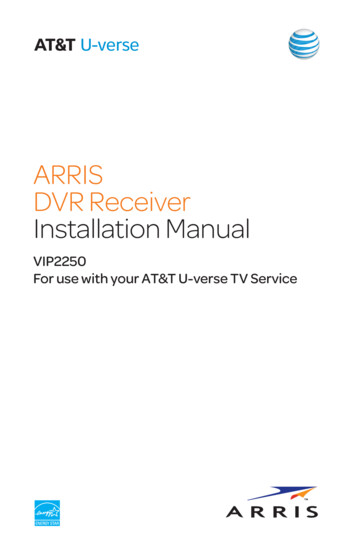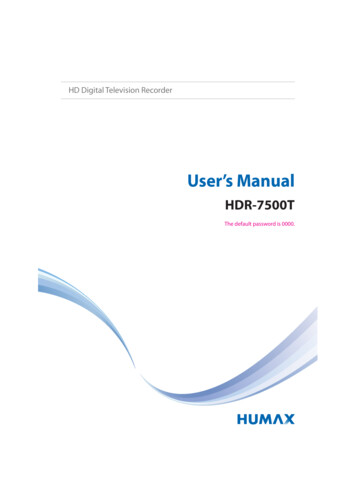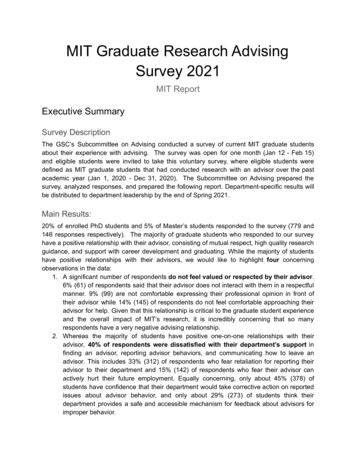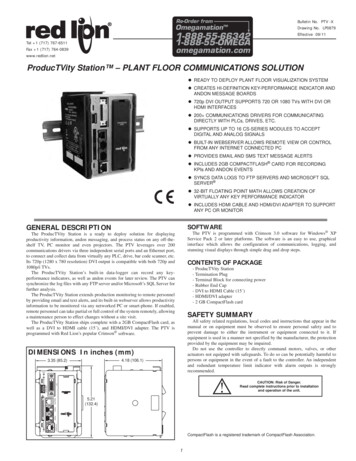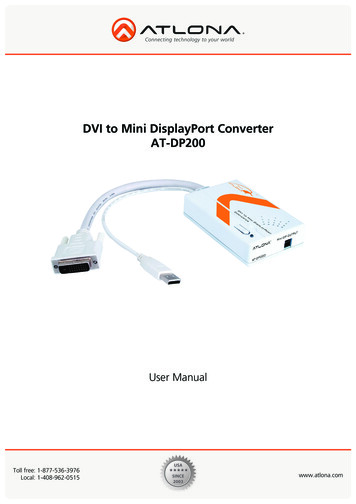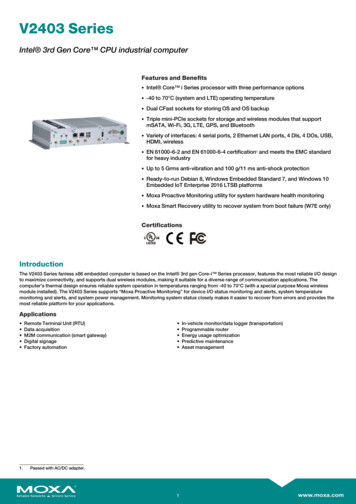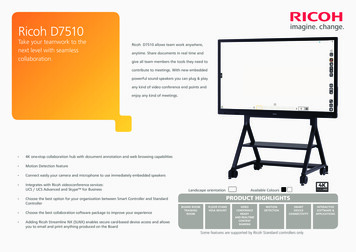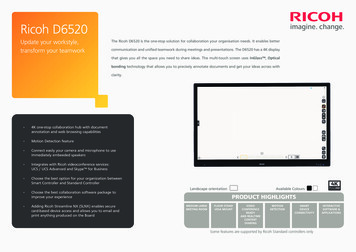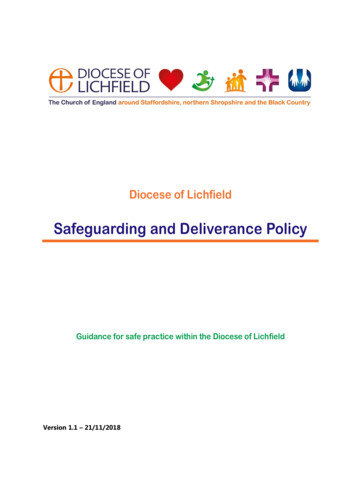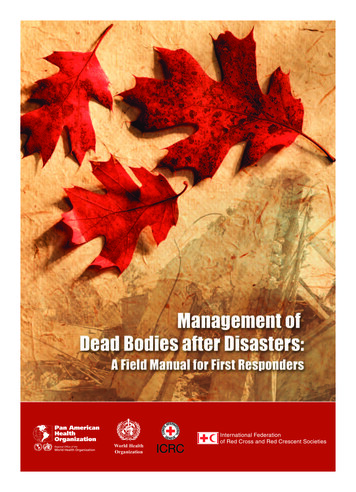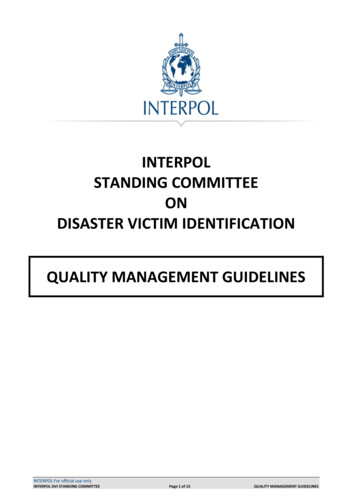
Transcription
INTERPOLSTANDING COMMITTEEONDISASTER VICTIM IDENTIFICATIONQUALITY MANAGEMENT GUIDELINESINTERPOL For official use onlyINTERPOL DVI STANDING COMMITTEEPage 1 of 15QUALITY MANAGEMENT GUIDELINES
1.INTRODUCTION1.1This document should be interpreted as guidelines, and not to supersede, replace, or override localjurisdictions policy or practice.1.2It is understood that for a particular DVI incident, a number of different organizations could beexpected to participate in the investigation. While it is not necessary for all these organizations tooperate under the one management system; each should develop a management system that is inline with these guidelines and that is appropriate for the range of disciplines, the activitiesconducted and conclusions given.1.3This document is applicable to all jurisdictions providing a DVI function including dedicated DVIteams, part-time DVI teams and teams convened on an incident-by-incident basis.1.4 These guidelines are applicable to those organizations that perform activities as part of the DVIprocess. This includes the Lead Agency and the organization/s that carry out the following functionsin support of the DVI process:Scene Operation Incident scene examination and recording Recovery and management of evidence Recovery and management of human remains Management of documents and informationPost Mortem (PM) Operation Receipt and management of human remains at the mortuary Forensic pathology Forensic odontology Fingerprint examination Radiography Forensic anthropology Physical examination Recovery and management of evidence and property Collection of DNA samplesDVI Ante mortem (AM) Operations Communication with next of kin Information collection Collection and management of evidence and property Collection of DNA samples Management of documents and informationReconciliation Management of documents and information Comparison/evaluation of AM and PM data including DNA analysis Victim identification Victim identification reportingINTERPOL DVI STEERING GROUPPage 2 of 15QUALITY MANAGEMENT GUIDELINES
1.5It is understood that particular organizations may use contract personnel for particular disciplines.Such personnel need to comply with the requirements of the DVI management system of theorganization to which they are contracted.2.TERMS AND DEFINITIONSJurisdictionA country, state or territory providing DVILead agencyThe organization responsible for the investigation of the DVI incidentOrganizationAn agency, group or functional area providing a DVI activityPhaseDVI comprises a number of separate but related phases, the scene, AMinformation collection, PM information collection, reconciliation andoperational debriefDisciplineAn activity performed by an organization within the DVI processAMAnte MortemPMPost MortemDNADeoxyribonucleic acid3.MANAGEMENT REQUIREMENTS3.1Organization3.1.1 The type and extent of the DVI service provided by an organization needs to be defined anddocumented. This could be in the form of a capability statement.3.1.2 It is important that command/management and supervisory positions within an organization duringa DVI operation are clearly defined and documented.a)Individuals in these positions need to have authority commensurate with their responsibilities.3.1.3 Each subordinate should be accountable to only one immediate supervisor.3.1.4 Roles and responsibilities for each DVI position should be documented.a)Individuals in these positions need to have a clear understanding of their roles and responsibilities.3.1.5 Appropriate supervision should be provided to all personnel during a DVI operation.3.1.6 Clear vertical, horizontal and diagonal channels of communication need to exist within the DVIorganization during the DVI operation.3.1.7 Effective communication ought to exist between the DVI Command and the separate DVIorganizations and disciplines during the DVI operation.3.1.8 At the jurisdictional level, the DVI Commander or delegate, should ensure that each organizationparticipating in the DVI process has in place a management system that is in line with therequirements of this document.a)Where an organization that participates in the DVI process has not established a DVI managementsystem the DVI Commander needs to communicate with the management of the organization toensure that the functions carried out during a DVI operation meet the required standard.INTERPOL DVI STEERING GROUPPage 3 of 15QUALITY MANAGEMENT GUIDELINES
3.2Quality Manual3.2.1 To ensure that all personnel understand what the expectations are and what is required of them,the DVI management system should be documented in a quality manual (or equivalent). Thedocument needs to clearly define the policies and objectives underpinning the DVI managementsystem.3.3Management of System3.3.1 A member of the DVI organization should be delegated the responsibility for the management ofthe DVI management system. This may involve the appointment of a quality manager, or if the sizeor operation of the organization does not justify a full time position, the nomination of an officerwho will perform the required role on a part time basis.3.3.2 The quality manager or nominated officer is responsible for co-ordinating the maintenance of themanagement system. This may include, but is not limited to: maintaining the quality manual and associated documentationmonitoring the DVI operations of the organization to verify compliance with procedures andpracticesreviewing DVI practices, procedures, operations and recommend necessary changesensuring the validation of new technical proceduresinvestigation of technical and procedural problems and making recommendations for remedialactionwhere required, administering the proficiency testing for affected DVI personnel, including theevaluation of resultsthe coordination and evaluation of internal audits and system reviewsensuring training records of DVI personnel are maintainedrecommending training to improve the skills of DVI personnelreview of feedback from customersrecommending changes and improvements to the DVI management system3.4Document Control 3.4.1 The DVI organization should establish and maintain procedures to control all documents that formpart of its DVI management system. These include those documents generated internally or fromexternal sources. Examples of these documents include plans, regulations, standards, policystatements, procedures, methods, instruction manuals, software programs, relevant text books etc.3.4.2 All documents issued to personnel in the DVI organization as part of the DVI management systeme.g. policies and procedures, should be reviewed and approved for use.3.4.3 A master list identifying the current revision status and distribution of documents in the DVImanagement system should be established and maintained.3.4.4 All internally generated documents within the DVI management system should be uniquely markedincluding, the date of issue and or revision, page numbering, total number of pages or significationof the end of the document, and the issuing/approval authority.3.4.5 Changes to documents should undergo a formal review and approval process. The reviseddocument needs to be issued as soon as practical.a)It is important that obsolete documents (or parts of documents eg individual procedures) aremarked as such and withdrawn from use.b)Obsolete documents are to be maintained in conformance with local archiving requirements.INTERPOL DVI STEERING GROUPPage 4 of 15QUALITY MANAGEMENT GUIDELINES
3.4.6 A record should be maintained of all changes effected to documents.3.5Subcontracting3.5.1 When an organization contracts DVI services, normally performed by the organization, whetherbecause of unforeseen circumstances or on a continuing basis, the services need to be placed with acompetent contractor. A competent contractor is one who complies with the organization’s DVImanagement system for the work to be undertaken. If the work is contracted to an organizationsuch as a forensic science laboratory, the laboratory should be accredited under an approvedforensic science accreditation program.3.5.2 The DVI organization should keep a register of all subcontractors used.3.5.3 Where organizations use subcontracted personnel (e.g. forensic odontologists), such personnelneed to comply with the requirements of the DVI management system of the subcontracting (i.e.requesting) organization.3.6Purchasing Services and Supplies3.6.1 A record of service providers, suppliers and their contact details should be maintained.3.6.2 The organization needs to ensure that purchased supplies that affect the quality of the DVI processare adequate and or comply with specifications.3.7Service to Customers3.7.1 It is important for the DVI organization to have policies and procedures for the effectivecommunication with interested parties . This should include monitoring the level of customersatisfaction. Issues applicable to DVI may include but are not limited to: Contact and liaison with relatives of victimsAccess to incident site by relatives of victimsProvision of counselling service to relatives of victimsLiaison with the mediaLiaison with investigatorsLiaison with members of parliament and government departmentsReligious and cultural requestsProvision of family liaison officers (FLO)Access to records and exhibits by interested parties or their representativesLiaison with embassiesLiaison with external police organizationsLiaison with airline industryLiaison with INTERPOLLiaison with government departmentsIndependent analysis of samples and or exhibits3.8Complaints3.8.1 It is important for the organization to have procedures for the investigation and resolution ofcomplaints.3.8.2 Records should be maintained of all complaints, their investigation and any actions taken.INTERPOL DVI STEERING GROUPPage 5 of 15QUALITY MANAGEMENT GUIDELINES
3.9Corrective Action3.9.1 The organization needs to establish policies and procedures for implementing corrective actionwhen departures from the policies and procedures in the DVI management system or technicaloperations have been identified.a)Where a problem is identified an investigation needs to be implemented by the organization todetermine the cause of the problem.b)Where the investigation indicates that corrective action is necessary to remedy the situation, theaction(s) implemented should be the most appropriate to eliminate and prevent a recurrence of thesituation. The corrective action taken should fit the magnitude and risk of the problem.c)Any changes implemented as a result of corrective action investigations should be documented.3.9.2 Recommendations for corrective action may be generated through: Internal audits and reviewsCustomer / interested party feedbackComplaintsQuality control dataAdministration and technical reviews of case filesProficiency testingOperational debriefsCoronial inquests (for those countries that have a coronial system)3.9.3 The quality manager or nominated officer should be responsible for co-ordinating the correctiveaction system.3.10 Preventive Action3.10.1The organization should have procedures in place to identify improvement opportunities proactivelyrather than in reaction to the identification of problems or from a complaint. The system shouldmake provision for staff contribution and input into improvements of the organization’s DVImanagement system.3.11 Control of Records3.11.1The DVI organization needs to establish and maintain procedures to control all records that relate toDVI operations or its DVI management system. This includes the identification, filing, storage,maintenance and disposal of records. Records falling within the categories include, case records,audit and review records, complaints, staff training records, proficiency testing records, correctiveaction reports, equipment maintenance.Note: Records may be in any media, such as hard copy or electronic media.3.12 Case Records3.12.1Case records include all examination/analytical and administration records generated by anorganization for a particular DVI case.3.12.2All records in relation to deceased persons, human remains and missing persons need to be linkedand traceable.INTERPOL DVI STEERING GROUPPage 6 of 15QUALITY MANAGEMENT GUIDELINES
a)Each body or human remain will be allocated a unique DVI number at the incident site. This is theprincipal identifier. Should additional identifiers be used, for example, mortuary referencenumbers, deceased’s property, or biological samples, these should be cross-referenced to theprincipal identifier.b)The principal identifier for a missing person will be their full name and date of birth. Shouldadditional identifiers be used, for example a missing person number, ante mortem file number,missing person’s property, biological samples, these should be cross-referenced to the principalidentifier.3.12.3Records supporting conclusions should be retained. It is important that records required to supportthe conclusions are such that in the absence of the original examiner, another competent examineror supervisor could evaluate what was done and interpret the data.3.12.4All records should include the identity of the person making the record.3.12.5Since case notes and records of conclusions may be the subject of courtaction and or subpoena, they should be recorded in a permanent manner. Handwritten notes should be inink and not pencil, although scene diagrams or sketches may be in pencil.3.12.6 Any alterations and or additions to a case record ought to be recorded. This includes the name orinitials of the person altering or adding to the record and the date.3.13 DVI Case Files3.13.1The DVI case file should incorporate all documentation relating to the DVIincident including phase 1 (scene investigation), phase 2 (post mortem information collection), phase 3(ante mortem information collection) and phase 4 (reconciliation) records.3.13.2The DVI case file should be allocated a unique DVI case number or case name.3.13.3Details of the contents of the case file should be included in the case file.3.13.4 Documents within a case file should be paginated using a numbering system, which indicates thetotal number of pages within the file.3.13.5Each page in the case file should bear the DVI case number or case name.3.13.6 Copies of reports submitted by the specialist identification areas (e.g. forensic odontology,fingerprints, DNA) supporting identifications should be retained with the case file.3.13.7 Documents relating to the identification of a particular deceased person i.e. Ante mortem andcorresponding Post Mortem DVI forms, identification reports, photographs, radiographs etc may bekept within the case file in individual envelopes or sachets. A description of the contents of eachenvelope or sachet, together with the total number of pages or items needs to be included in thefile and the envelope or sachet should be paginated.3.13.8DVI case file retention times will be in line with jurisdictional legislative requirements.3.13.9The completed case file needs to be stored in a designated, secure location.3.14 Internal Audits3.14.1The organization should conduct internal audits of the DVI activities annually to ensure thatoperations continue to comply with the DVI management system. The review needs to cover bothINTERPOL DVI STEERING GROUPPage 7 of 15QUALITY MANAGEMENT GUIDELINES
the technical and managerial aspects of the operation and cover all elements of the DVImanagement system.3.14.2Internal audits need to be performed by trained and suitably qualified personnel for the specificactivity. Where possible the auditors should be independent of the activity to be audited.3.14.3When an audit identifies deficiencies in operations or in the correctness or validity of thetest/examination results or the conclusions drawn, the DVI organization should take immediateaction to correct the situation. The DVI Commander and Coroner (for those countries that have acoronial system) should be notified immediately where the investigations show that identificationsmay have been compromised.3.14.4A record should be kept by the organization on the area of activity audited, the audit findings andany corrective actions recommended.3.14.5A follow up audit may be conducted where corrective actions have been undertaken to ensureimplementation and effectiveness of action taken.3.15 Management Review3.15.1The DVI organization should be reviewed annually by its executive management to evaluate theorganization’s DVI management system and activities to ensure suitability and effectiveness and tointroduce any changes or improvements. The finding from the review and any action recommendedshould be recorded. The review may include the evaluation of the following: Suitability of policies and proceduresManagerial and supervisory reportsOutcomes of internal auditsCorrective and preventive actions takenProficiency test resultsChanges in the type and flow of workCustomer feedback and complaintsStaff trainingResources4.0TECHNICAL REQUIREMENTS4.1Personnel4.1.1 Organizations involved in the DVI process need to ensure the competence of all those operatingwithin the separate phases of the DVI process.a)All personnel involved in the DVI process should have appropriate education, training, experienceand or demonstrated skills for their specific area of involvement.b)When using staff in training, appropriate supervision needs to be provided.4.1.2 The DVI Commander should be a senior police officer with relevant scientific or emergencymanagement qualifications and or experience. The officer also needs to be experienced incommand, control and coordination arrangements.4.1.3 The coordinators for each of the DVI phases should be individuals with knowledge and experience inthe respective area and with the ability to coordinate and manage that phase of the DVI operation.INTERPOL DVI STEERING GROUPPage 8 of 15QUALITY MANAGEMENT GUIDELINES
4.1.4 The team leaders of the specialist sections in the identification process i.e. fingerprints, forensicodontology, medical, physical and molecular biology should be senior practitioners from thediscipline with extensive experience in forensic examinations, comparisons and technical reviews.4.1.5 Personnel of specialist sections that provide opinions or conclusions which can independently leadto the identification of a deceased i.e. fingerprints, forensic odontology, medical and molecularbiology, should be authorized by their respective organization to provide those opinions orconclusions. The authorizations should be in writing and retained by the organization.4.1.6 Organizations need to ensure that appropriate training programs are in place and documented foreach of the functional areas associated with DVI.4.1.7 Training records should be maintained for all DVI personnel. These may include: relevant academic qualificationsrelevant training courses attended, internal and externalconferences, seminars, workshops attended4.1.8 Where contracted or additional staff, from outside the organization, are engaged to assist in aparticular DVI function or activity e.g. interstate or international odontologists, the organizationneeds to ensure that such personnel are supervised and competent and that they work inaccordance with the management system.4.2Accommodation and Environmental Conditions4.2.1 For those DVI phases where operations are conducted within a laboratory or office environment,the following issues should be addressed: Each officer should have adequate space.Where possible there needs to be a clear delineation of areas used for laboratory and clericalfunctions.Adequate space should be available for equipment and tools.Adequate space should be available for records etc.Adequate lighting needs to be available.The physical design of areas should facilitate free flow of work.Bench and floor spaces should be appropriate for the work performed.The temperature and ventilation needs to be adequate to suit the circumstances.Physical separation between low-level and high-level tasks, e.g. DNA analysis.4.2.2 Storage areas for human remains, evidence and property need to be secure to prevent theft orinterference and there should be limited, controlled access. The storage conditions should be suchas to prevent loss, deterioration and contamination and to maintain the integrity of and identity ofthe evidence. This applies to both before and after examinations have been performed.4.2.3 Access to all operational areas relating to a DVI incident should be restricted to authorizedpersonnel and controlled. A record should be retained of all unauthorized personnel visitingoperational areas.Health Safety and Welfare4.2.4 The DVI organization’s occupational health safety and welfare program should be documented andbe readily available to all effected staff. The document may be dedicated specifically for DVI or theDVI role may form part of an overall manual utilized by an overarching group.4.2.5 The organization is to ensure that policies and procedures relating to safety conform to relevantjurisdictional occupational, health and safety provisions.INTERPOL DVI STEERING GROUPPage 9 of 15QUALITY MANAGEMENT GUIDELINES
4.2.6 Appropriate personal protective equipment (PPE) needs to be provided by the organization andworn by relevant DVI personnel.4.2.7 First aid kits need to be provided.4.2.8 Annual health and safety audits should be conducted by the organization to ensure conformancewith requirements.a)Where an audit identifies departures from policies and procedures appropriate corrective actionprocedures need to be implemented.b)A record of all safety audits should be maintained by the DVI organization.4.3Procedures and Methods4.3.1 Each organization within the DVI process must have documented operational procedures.4.3.2 The overall response procedures for the individual phases should be based on the Interpol DVIGuide and any jurisdiction manual.4.3.3 The individual procedures and methods used by the separate disciplines should conform to thosewhich are generally accepted within the respective field e.g. forensic and medical science, and aresupported by accepted literature or data.4.3.4 Departures from standard procedures and methods may be required in certain circumstances. Anysuch variations should be justified, validated and documented in the DVI case notes. Suchdepartures should be approved by the respective phase coordinator or where necessary, by the DVICommander.4.3.5 All documents that describe procedures and methods should include in addition to a description ofthe key steps, the following information where appropriate: OH&S considerations including any warnings, safe handling and PPE issuesEquipment required including special consumablesPrecautions, possible sources of error or limitations of a procedure or methodCriteria that specifies when results, observations and conclusions should be rejectedHow observations and data should be recorded, analyzed and presented including the preparationof court statementLiterature references when appropriateQuality assurance measuresSelection of Procedures and Methods4.3.6 Examination and test procedures used by the DVI organization should be generally well acceptedwithin the forensic and medical science fields. The principal factor behind the selection of a methodis that the method is demonstrably capable of producing valid results.4.3.7 Where a procedure indicates that a test can be performed by more than one method, there shouldbe documented criteria for method selection.4.3.8 Wherever possible, non-destructive tests should be used. Should a destructive test be necessarythe procedures need to ensure that as much material as possible is retained from the original testshould a reanalysis be required.INTERPOL DVI STEERING GROUPPage 10 of 15QUALITY MANAGEMENT GUIDELINES
4.3.9 It is recognized that more than one acceptable method may exist to accomplish a particular task orexamination. Due to the considerable variation that exists within DVI incidents involving sceneoperations, practitioners need to be able to use professional judgment in choosing the methodmost appropriate to the situation at hand. Where variations in methods do occur, a notation of thedeviation should be made in the officer’s DVI case notes.4.3.10The decision about which procedures should be used at the incident site is to be made by the teamleader in consultation with the DVI site coordinator.Method Validation (Scientific)4.3.11Method validation within DVI means that procedures or methods are either documented inforensic/medical/dental or other recognised literature and or otherwise tested by the DVIorganization to confirm the reliability of results. The validation process should identify the criticalaspects of the procedure that need to be carefully controlled and monitored.4.3.12Methods within DVI that need to be validated include: Non standard methodsLaboratory designed and developed methodsStandard methods used outside their intended scopeMethods where there is a significant modification to a standard method4.3.13The extent to which a method requires evaluation prior to implementation during a DVI incidentdoes require professional judgment and it will ultimately be the decision of the DVI Commander inconsultation with relevant discipline managers/coordinators. The extent of the validation requiredwill be dependent on meeting the needs of the given application. In general, acceptance of a newmethod or a modified method based on a literature report may not be sufficient, further internalvalidation may be required by the organization.4.3.14All validated methods developed by a DVI organization should initially be reviewed by the relevantdiscipline manager/coordinator. The organization’s management should be the authorizingauthority for all methods used.4.3.15The proper design of a validation study will be dependent on understanding the theoretical basis forthe method which facilitates assessing the specificity and limitations of the method and identifyingpossible sources of error.4.3.16All new methods should be tested using known samples and standard reference materials, includingcomparison with established methods.4.3.17A record should be made of the validation results and validation techniques used.Standards and Reagents4.3.18Where applicable, commercial and locally prepared reagents need to be of sufficient quality toensure accuracy of procedure and should be maintained to guard against deterioration.4.3.19An inventory of materials should be maintained by the organization.INTERPOL DVI STEERING GROUPPage 11 of 15QUALITY MANAGEMENT GUIDELINES
4.3.20Reagents should be labelled with: name of the reagent concentration, where appropriate preparation date expiration date (where appropriate) identity of the preparer hazard warning, where appropriateControl of Data4.3.21Where calculations or data transfer occur through a process that does not form part of a validatedelectronic procedure, they should then be validated by a second suitably qualified person. Theindependent verification should be recorded in the case file.4.3.22Software packages used within the organization that form part of the test result process and whichmay be used in legal proceedings should be suitably validated. The validation may be performed bythe supplier prior to purchase. In such cases, a certificate is required from the supplier ensuringcompliance with the relevant national or international standard. Where validation is performed bythe supplier the process should be conducted by the organization following national or internationalguidelines.4.3.23The validation of software used in a laboratory procedure should form part of the overallmethod/procedure validation process.4.4Equipment4.4.1 The organization should maintain a range of equipment and instruments appropriate to the DVIactivities undertaken. Where equipment outside the organization’s permanent control is used, therequirements of this section need to be met.4.4.2 Records of each item of equipment should be maintained. This includes:identity of the item of equipmentmanufacturer’s name, type identification, and serial number or other identificationcurrent location, where appropriatemanufacturer’s instructionsmaintenance planmaintenance, service and repair records4.4.3 The organization should have procedures for the safe handling, transport, storage, use andmaintenance of equipment to ensure proper functioning, and in order to prevent contaminationand deterioration.4.5Calibration of Equipment4.5.1 All equipment used by the DVI organization for conducting tests should be capable of achieving thelevel of accuracy and reliability required. Organizations should determine the accuracy andprecision requirements for each item of equipment and set an equipment calibration/verificationprogram (including a schedule) accordingly.4.5.2 Instruments and/or equipment used for critical measurements in the DVI process need to becalibrated. Calibrations should be traceable to the International System of Units.4.5.3 Calibration procedures should be documented.INTERPOL DVI STEERING GROUPPage 12 of 15QUALITY MANAGEMENT GUIDELINES
4.5.4 When intermediate checks are needed to maintain confidence in the calibration status ofequipment, these checks should be carried out according to a documented procedure.4.5.5 Calibration records and records of intermediate checks should be maintained by the organization.4.6Evidence Management/Exhibit Control4.6.1 The organization should have a documented evidence management system. This system shouldinclude procedures for the collection, receipt, handling, protection and storage of items/evidence.4.6.2 Policies and procedures should be in place for the retention and disposal of exhibits following thecompletion of the examination and/or testing.4.6.3 The organization should have procedures and appropriat
INTERPOL DVI STEERING GROUP Page 2 of 15 QUALITY MANAGEMENT GUIDELINES 1. INTRODUCTION 1.1 This document should be interpreted as guidelines, and not to supersede, replace, or override local jurisdictions policy or practice. 1.2 It is understood that for a particular DVI incident, a number of different organizations could be
